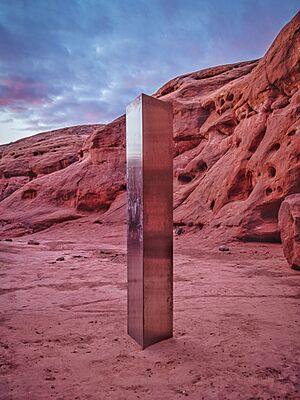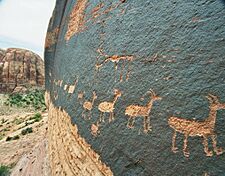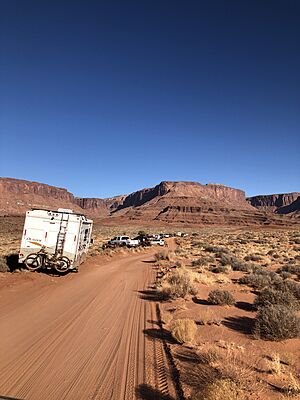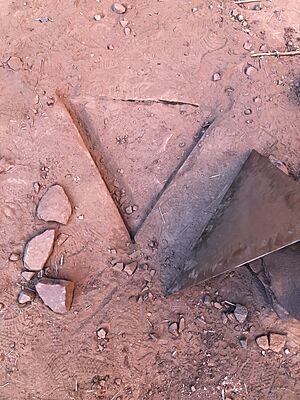Utah monolith facts for kids
Quick facts for kids Utah monolith |
|
|---|---|

The monolith at its original location
|
|
| Artist | Unknown |
| Year | 2016 |
| Type | Metal sculpture |
| Medium | stainless steel or aluminum (assumed) |
| Dimensions | 291 cm × 50.6 cm × 58 cm (114.5 in × 19.92 in × 23.0 in) |
| Condition | disassembled but later reassembled |
| Location | formerly Lockhart Basin in San Juan County, Utah, United States; 27 km (17 mi) southwest of Moab, currently held at undisclosed location by the Bureau of Land Management |
| 38°20′35.1″N 109°39′58.3″W / 38.343083°N 109.666194°W | |
The Utah monolith was a metal pillar that stood in a red sandstone slot canyon in northern San Juan County, Utah, United States. The pillar was 3 m (9.8 ft) tall and made of metal sheets riveted into a triangular prism. It was unlawfully placed on public land between July and October 2016; it stood unnoticed for over four years until its discovery and removal in late 2020. The identity of its makers is unknown, as are their objectives.
Utah state biologists discovered the monolith in November 2020 during a helicopter survey of wild bighorn sheep. Within days of its discovery, members of the public found the pillar using GPS mapping software and made their way to the remote location. Following intense media coverage, it was covertly removed on November 27, 2020, by four residents of Moab, Utah. After nearly a month in their possession, the monolith was given to the Bureau of Land Management and is currently in their custody.
Following the discovery of the monolith, over two hundred similar metal columns were erected in other places throughout the world, including elsewhere in North America and countries in Europe and South America. Many were built by local artists as deliberate imitations of the Utah monolith.
Discovery
On November 18, 2020, wildlife officials with the Utah Division of Wildlife Resources were in southeastern Utah conducting a survey of bighorn sheep from a helicopter piloted by the Utah Department of Public Safety (DPS). While flying over a slot canyon in a remote area, one of the wildlife officials spotted the pillar and told the pilot, Bret Hutchings, to fly over the location again. Hutchings described the moment:
One of the biologists is the one who spotted it and we just happened to fly directly over the top of it. He was like, "Whoa, whoa, whoa, turn around, turn around!" And I was like, "What?" And he's like, "There's this thing back there – we've got to go look at it!"
Hutchings noted that the object appeared to be manmade and had been planted in the ground instead of being dropped from the sky. Hutchings added: "We were kind of joking around that if one of us suddenly disappears, then the rest of us make a run for it."
On November 20, the Utah DPS posted a photo of the pillar on Instagram. On November 23, the Utah DPS released videos and photographs of the object, but not its exact location, on their website, writing: "DPS Aero Bureau Encounters Monolith in Red Rock Country".
Location and dating

The monolith was installed by unknown individuals on public land in a red sandstone slot canyon in Lockhart Basin, in northern San Juan County. It was located on public land in an area that was removed from the Bears Ears National Monument (a protected area in Utah) in 2017; the area was later added once more to the national monument in 2021. The site had no public services such as parking, restrooms, or cell phone service.
The exact location of the monolith was not disclosed by the DPS, to prevent people from endangering themselves while trying to find it. Within hours of the DPS announcement, Reddit user Tim Slane had identified the object on Google Earth. Slane compared the flight path of the state biologists' helicopter against the red-and-white sandstone terrain from their videos. Slane told The Verge that "he was aided by clues like the cliffs' height, the canyon's erosion pattern (indicating a more exposed area), and a flat floor suggesting it wasn't frequently flooded (and, by extension, was near the top of a watershed)". Google Earth satellite images showed that the monolith was installed between August 2015 and October 2016, and that surrounding scrub vegetation had been cleared.
Dutch journalist Nouska du Saar, who specializes in open-source intelligence, used Maxar satellite images to determine that the monolith appeared between July 7, 2016, and October 21, 2016.
Within 48 hours of the DPS announcement, members of the public had reached the site and uploaded photographs and videos of the monolith to social media. Local residents began to fear a surge in foot traffic could damage local Native American sites and artifacts.
Description
The metal structure stood 3 m (9.8 ft) tall above the bedrock, with each of the sides being 58 cm (23 in) wide. A triangular prism, it had three sides, was not magnetic, and appeared to be made of 1/8th inch stainless steel or aluminum sheets, joined with rivets, with a hollow interior. There was silicone caulk or epoxy along the base, and striking the metal produced a dampened sound indicating some type of insulation inside. The pillar was assembled using blind rivets, indicating human origins but making it difficult to determine its age.
Dave Sparks of the TV show Diesel Brothers went to the monolith and described it in a video he posted on Instagram. "They got a concrete saw and they cut it into the red rock there", he said. "You can see right here on the bottom where they had a couple of over cuts with the saws." Wendy Wischer of the University of Utah's School of Fine Art said, "One person alone could not have done it so there is a group of people who have some knowledge of it somewhere. Most artists want some recognition for what they are doing but this seems to include a level of humor and mystery as part of the intention".

On first discovering the pillar, the DPS described it as a "monolith", a term since repeated by other major media outlets. Although the word monolith refers to a single great stone, the word has also become closely associated with the Monolith from the movie 2001: A Space Odyssey, to which the Utah monolith bears circumstantial resemblance.
Legality

The DPS released a statement quoting Bureau of Land Management (BLM) regulations that it is illegal to install structures (including art), on public lands without permission, "no matter what planet you're from".
The Utah Department of Heritage & Arts said in a statement on their Twitter feed that the monolith is vandalism, and are concerned about damage to ancient artwork and archeological artifacts in the region.
The #UtahMonolith has prompted discussions about public art and inspired people to visit the site, despite efforts to keep it secret. Our department includes @UT_Indian @UTHistory @UtahArtsMuseums, and we want to raise a couple of important points. [...]
First, debates about #UtahMonolith as artistic statement shouldn’t equate it with rock art. This piece is a contemporary statement. Ancient petroglyphs, pictographs, and rock art are protected archaeological treasures with established cultural and historical significance.
While curiosity is understandable, we discourage visiting the monolith. Along with safety concerns, increased crowds threaten the archaeological resources in the area. Unintentional damage is still damage.
If you still choose to visit, please do not damage any rock art and don’t gather archaeological items such as arrowheads. Leave the area as undisturbed as possible.
Finally, while the monolith has better craftsmanship than graffiti, this is still vandalism. It irreversibly altered the natural environment on public lands. While the monolith is interesting, we cannot condone vandalism of any type.
Removal
The Utah division of the Bureau of Land Management (BLM) said that it received credible reports that the monolith was removed on the evening of November 27, 2020, by a then-unknown party, now known to be the Moab-based recreationists Andy Lewis, Sylvan Christensen, Homer Manson, and an anonymous companion. Several adventure photographers posted details and pictures about the dismantling and removal of the monolith. One witness reported that the four men had pushed the monolith over without tools, while onlookers watched, saying "this is why you don't leave trash in the desert" before breaking it apart and carrying away the pieces in a wheelbarrow. The group referred to the conservation ethic of "Leave No Trace". Photos of the site afterwards posted by visitors showed that all was left was a triangular metal piece (see photo), and witnesses reported seeing a pickup truck driving away from the site, carrying an object, as they approached.
The BLM in Utah released a statement on the agency Facebook page on November 28, 2020, saying they did not remove the monolith, and because the structure is considered private property they would not investigate it further, leaving it to the local sheriff's office. The local San Juan County Sheriff's Office said they could not devote the resources, although they did post a Most Wanted poster on their Facebook page. On November 30, 2020, authorities reversed their initial decision, and planned a joint investigation with the Bureau of Land Management. Alan Freestone, chief deputy in San Juan County, confirmed on December 1, stating: "I know they have some leads, and that's all we are saying right now."
Four days after the monolith's removal, Lewis and Christensen posted a video online entitled "We Removed the Utah monolith", showing what they claimed was themselves and two other people hauling away the Utah monolith in a wheelbarrow. Christensen posted the same video to TikTok and Instagram citing "clear precedents for how we share and standardize the use of our public lands, natural wildlife, native plants, fresh water sources, and human impacts upon them", and highlighting the damage done to the area by the large number of sightseers arriving in an area with no parking facilities or restrooms. In several interviews since the video's release, Christensen said he had received hateful comments and threats of death and physical harm as a result of his video.
On December 20, 2020, over a month after the monolith's initial discovery, Lewis released a pre-recorded video on Instagram, allegedly in response to the numerous death threats, showing what appeared to be the Utah monolith intact in his backyard, contrary to speculation that it had been destroyed. He claimed that he and his friends had also heard of plans to completely destroy it on the night of its eventual removal, plans that they later found to be true, so his team removed it before it could be destroyed by others. He also revealed that they had since donated it to the Bureau of Land Management to investigate its origin and creation, and eventually find a new home for it.
Similar monoliths
Shortly after the discovery of the monolith in Utah, over two hundred additional monoliths which resembled the Utah monolith began appearing at various locations across the world. In some cases, local artists came forward to claim responsibility for them, citing the Utah monolith as their inspiration. Other monoliths were created and installed by small businesses for promotional purposes.
See also
- Minimalism (visual arts)
- Seattle Monolith
- Site-specific art
- Trail ethics



